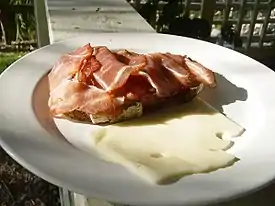
Westphalian ham (German: Westfälischer Schinken) is a ham that was originally produced from acorn-fed pigs raised in the forests of Westphalia, Germany.[1][2] The resulting meat is dry cured and then smoked over a mixture of beechwood and juniper branches.[1][3][4][2]
The hams are prepared for consumption solely by the process of smoking, which preserves them, and are typically eaten thinly sliced in their preserved state without additional cooking.[3][5][6][7][8]
History
During his travels in Germany, Thomas Jefferson documented the production of Westphalian ham and aspects of the hogs used to produce it.[1]
In the early 1900s, there were three varieties of Westphalia ham: kugel cut, boneless and rolled, and regulation ham.[9]
In the early 1900s, significant quantities of Westphalian ham were being exported from Germany into the United States.[3]
See also
References
- 1 2 3 Hayes, Kevin J. (2008). The Road to Monticello: The Life and Mind of Thomas Jefferson. Oxford University Press. pp. 363. ISBN 0199758484.
- 1 2 The Encyclopedia of Healing Foods - Michael T. Murray, Joseph E. Pizzorno. p. 616.
- 1 2 3 4 Daily Consular and Trade Reports. Department of Commerce and Labor, Bureau of Manufactures (U.S.). 1912. p. 55.
- 1 2 Swindled: The Dark History of Food Fraud, from Poisoned Candy to Counterfeit ... - Bee Wilson. p. 11.
- ↑ Processed Meats. p. 344.
- ↑ German Cooking - Marianna Olszewska Heberle. pp. 166-167.
- ↑ The Boston Cooking-school Cook Book - Fannie Merritt Farmer. p. 238.
- ↑ Handbook of Poultry Science and Technology, Secondary Processing. p. 218.
- ↑ Rivers, Frank (1916). The Hotel Butcher, Garde Manager and Carver. Hotel Monthly Press. pp. 45–46.
